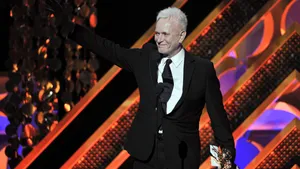Humans often want to fix things about ourselves that aren't broken. From foot-binding to plain old circumcision, our species has historically been obsessed with altering our bodies -- which I can't help but think about today as it's Intersex Awareness Day. The observance commemorates the first protest by intersex people -- those of us born with atypical sex characteristics -- against the practice of subjecting intersex infants and minors to cosmetic, sex trait-altering medical procedures, on October 26, 1996.
The impetus for fixing is so prevalent regarding the intersex population that it's often come to define us, via statements such as "Intersex? You mean those people who are operated on as babies?" that I've heard countless times as a longtime advocate for the intersex community. While I'm thrilled that awareness about these nonconsensual medical procedures is growing, it's notable that we don't define other populations this way. For example, although circumcision is the most common surgery performed on males, imagine how weird it would sound to hear males defined as "people whose penises are operated on in infancy."
Given said weirdness, today I'd like to highlight the fact that intersex people are much more than just the medical procedures that we are often subjected to -- and that we've been around way before they even existed. Take, for example, Gen. Casimir Pulaski, born in Poland in 1745 and known as the "Father of the American Cavalry." As the Smithsonian documentary The General Was Female? details, when the monument marking Pulaski's grave was temporarily removed, his remains were discovered to have certain female characteristics. After years spent analyzing his skeleton and DNA, a team of researchers concluded that Pulaski was probably born intersex, with XX chromosomes.
Despite his XX chromosomes, Pulaski appeared male at birth because of his intersex variation, Congenital Adrenal Hyperplasia (CAH), which often masculinizes genitalia, Pulaski was able to serve in the military, becoming an American Revolutionary War hero after relocating from Europe. He is believed to have saved George Washington's life in the Battle of Brandywine and is one of only eight people to be awarded honorary American citizenship, along with notables such as Winston Churchill and Mother Teresa.
Pulaski's story illustrates that intersex people have been thriving for centuries before the surgeries used to change us existed, and it's also a stark reminder of the harms and limitations of our current "fix it" approach. For today, in situations like Pulaski's -- where an individual has XX chromosomes and a variation known as congenital adrenal hyperplasia -- medical experts routinely recommend surgical reduction of the phallic structure and estrogen hormone therapy to feminize the child's body and assign them female. The assumption is that, due to their XX chromosomes, these individuals are "really" girls and should thus be made to look it. Yet there's Pulaski, a man more successful than most of his counterparts.
We can only speculate about the countless other intersex people throughout history because, as with other LGBTQI+ folks, most of our history has been lost due to the fact that we've only recently been able to live openly as who we are. For example, when the news broke that Hollywood film legend Rock Hudson was gay, my mother, like many, had a hard time believing it. Had it not been verified after Hudson became the first major celebrity to die of AIDS-related causes, in 1985, he would have lived and died being misperceived as heterosexual. Similarly, had Pulaski's remains not been uncovered, we would have never known that the prominent military hero was intersex.
Today, the vast majority of intersex people are still living this way -- with their intersex status publicly unknown. It's easy for me to understand why because until I was 28 I'd been living the same way. Although I'd been "out" as a lesbian for a decade, since college, everyone but my lovers and a handful of friends believed I was a non-intersex female. I knew I was different because my physical differences are very visible, but coming out as intersex in a world that only acknowledged males and females just didn't seem like an option in the 1980s and early 1990s.
I came out precisely when and because I was asked, in 1996, to do so by a survivor of childhood surgeries, sometimes referred to as intersex genital mutilation. She had learned that I like my intersex body and feel blessed that I wasn't subjected to IGM, and she thought it would be useful for people to hear this perspective. Having learned about the lifelong physical and psychological harms that often result from IGM -- which can involve involuntary sterilization or the loss of sexual sensation, I agreed. I wanted the world to know that doctors' claims that intersex children need to be altered in order to be happy are, in my experience, false.
Those who've watched me explore my intersex-ness since my 20s have, like me, viewed it as a positive aspect of who I am -- one friend just recently called it my "superpower." While I reminded her that millions of intersex people have not been afforded these experiences due to IGM and that even for me it wasn't always easy due to societal ignorance about intersex people, the irony of her statement wasn't lost. For me, being intersex has been a beautiful adventure, full of unexpected sexual pleasure and a rich understanding of both male and female experiences that I feel privileged to have known -- which is essentially the opposite of what doctors who promote IGM predict intersex people will experience.
Incidentally, proponents of IGM like to dismiss my experience as an exception. Perhaps I just want to be different, some speculate, which makes me laugh out loud. As the queer child of Latinx immigrants in a white neighborhood and school and having a name so unusual I grew up hearing, "Hida, what's that?" I often longed to blend in. Or, some speculate, perhaps I'm just unusually self-confident, in a way that we can't expect normal people to be. Far from it! As those close to me know, I suffer insecurities as much as everyone else.
The true reason I like being intersex is simple: When you don't raise a child to believe they're defective, they're more likely to end up feeling good about who and what they are -- and it's my hope that all future generations of intersex people are given the chance to experience this. On that note, a growing number of medical associations have begun to listen to intersex people. They are honoring their oath to "first do no harm" by recommending that no cosmetic surgeries be performed unless intersex people seek them out for themselves, as other adults sometimes do, and we couldn't be more grateful.
Hida Viloria is the author of Born Both: An Intersex Life and is a long-term intersex advocate.
Views expressed in The Advocate's opinion articles are those of the writers and do not necessarily represent the views of The Advocate or our parent company, Equal Pride.




































































Charlie Kirk DID say stoning gay people was the 'perfect law' — and these other heinous quotes